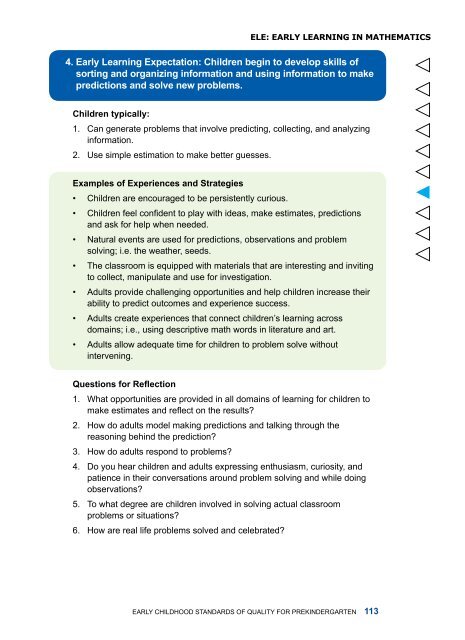Early Childhood Standards of Quality for ... - State of Michigan
Early Childhood Standards of Quality for ... - State of Michigan
Early Childhood Standards of Quality for ... - State of Michigan
Create successful ePaper yourself
Turn your PDF publications into a flip-book with our unique Google optimized e-Paper software.
ELE: early Learning in maTHEMATICS4. <strong>Early</strong> Learning Expectation: Children begin to develop skills <strong>of</strong>sorting and organizing in<strong>for</strong>mation and using in<strong>for</strong>mation to makepredictions and solve new problems.Children typically:1. Can generate problems that involve predicting, collecting, and analyzingin<strong>for</strong>mation.2. Use simple estimation to make better guesses.Examples <strong>of</strong> Experiences and Strategies• Children are encouraged to be persistently curious.• Children feel confident to play with ideas, make estimates, predictionsand ask <strong>for</strong> help when needed.• Natural events are used <strong>for</strong> predictions, observations and problemsolving; i.e. the weather, seeds.• The classroom is equipped with materials that are interesting and invitingto collect, manipulate and use <strong>for</strong> investigation.• Adults provide challenging opportunities and help children increase theirability to predict outcomes and experience success.• Adults create experiences that connect children’s learning acrossdomains; i.e., using descriptive math words in literature and art.• Adults allow adequate time <strong>for</strong> children to problem solve withoutintervening.Questions <strong>for</strong> Reflection1. What opportunities are provided in all domains <strong>of</strong> learning <strong>for</strong> children tomake estimates and reflect on the results?2. How do adults model making predictions and talking through thereasoning behind the prediction?3. How do adults respond to problems?4. Do you hear children and adults expressing enthusiasm, curiosity, andpatience in their conversations around problem solving and while doingobservations?5. To what degree are children involved in solving actual classroomproblems or situations?6. How are real life problems solved and celebrated?<strong>Early</strong> <strong>Childhood</strong> <strong>Standards</strong> <strong>of</strong> <strong>Quality</strong> <strong>for</strong> Prekindergarten 113


